| Author |
Message |
|
Borger Kruge
Location: Norway Joined: 13 Sep 2003
Posts: 20
|
 Posted: Fri 12 Dec, 2003 2:48 pm Post subject: "Wavy" blades on Lutel two-handers? Posted: Fri 12 Dec, 2003 2:48 pm Post subject: "Wavy" blades on Lutel two-handers? |
 |
|
Hi, all
Lutel has something they call a "wavy" blade on a couple of their two-handers. It appears that the blade itself actually has the general shape of waves close to the quillon block. Their pictures do not show how far these waves go down the blade.
Not knowing much about medieval two-handers I ask: is this historic in any way? It's a bit surprising to me if swords of the 16th century had such a hard-to-produce feature, but I'm no expert. Wouldn't this weaken the sword?
Comments or clarifications appreciated, thanks,
Borger
 Attachment: 45.85 KB Attachment: 45.85 KB
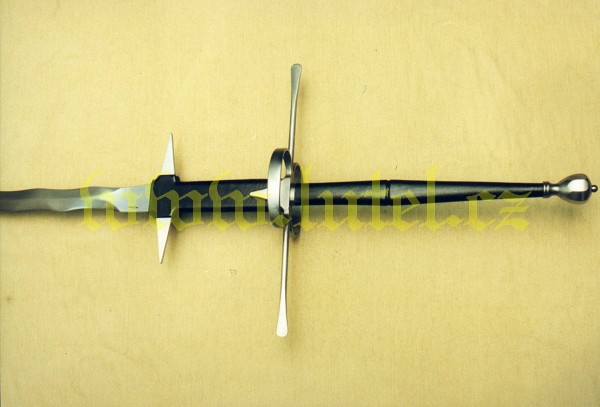
|
|
  |
 |
Thomas McDonald
myArmoury Alumni


|
 Posted: Fri 12 Dec, 2003 3:07 pm Post subject: Posted: Fri 12 Dec, 2003 3:07 pm Post subject: |
 |
|
From ARMA 's site :
The Flamberge
An unusual waved-bladed rapier popular with officers and upper classes during the 1600s. It was considered to look both fashionable and deadly as well as erroneously believed to inflict a more deadly wound. When parrying with the flamberge, the opponent's sword was slowed slightly as it passed along the length. It also created a disconcerting vibration in the other blade. The term flamberge was also used later to describe a dish-hilted rapier with a normal straight blade. Certain wave or flame-bladed two-handed swords have also come to be known by collectors as "flamberges", although this is inaccurate. Such swords are more appropriately known as "flammards" or "flambards".
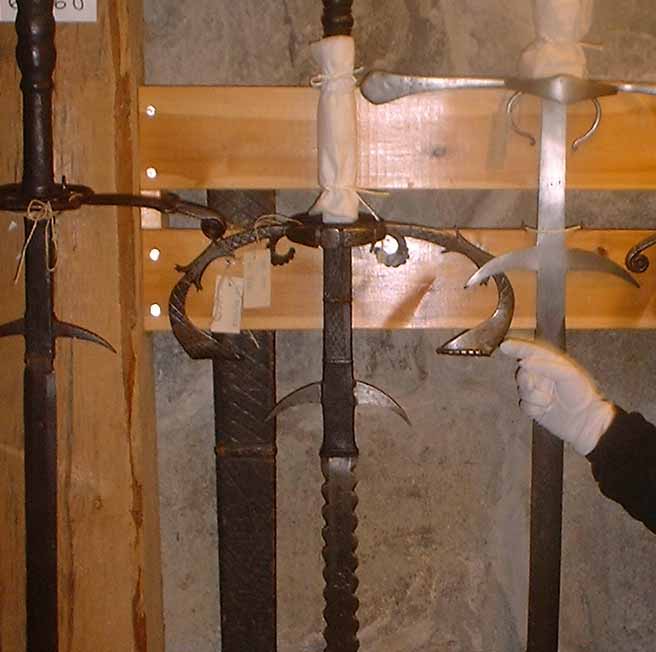
http://www.thehaca.com/spotlight.htm
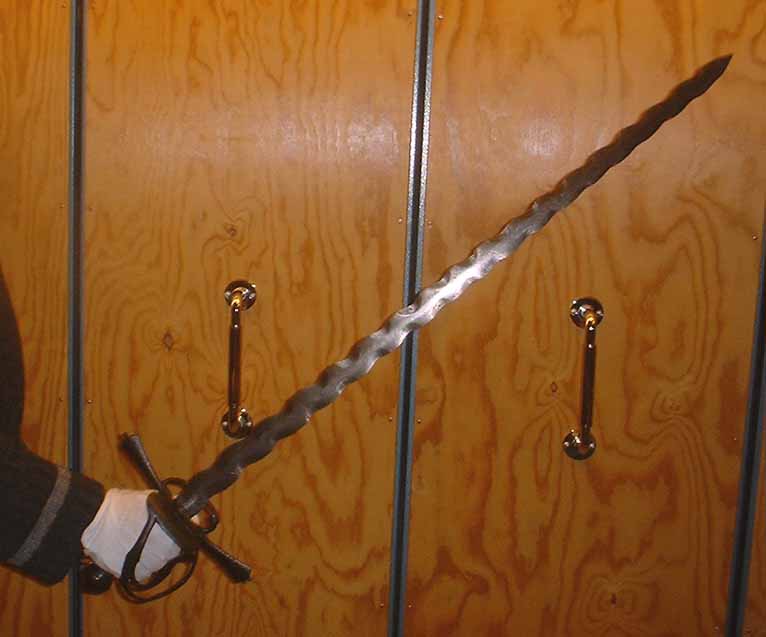
'Gott Bewahr Die Oprechte Schotten'
XX ANDRIA XX FARARA XX
Mac's PictureTrail
|
|
   |
 |
Nathan Robinson
myArmoury Admin


|
|
    |
 |
Björn Hellqvist
myArmoury Alumni


|
 Posted: Fri 12 Dec, 2003 4:17 pm Post subject: Posted: Fri 12 Dec, 2003 4:17 pm Post subject: |
 |
|
Hi, Borger! As for the Lutels, they are less wavy than their historical counterparts, but the waves go all the way down to the point. The wavy zweihänders are quite manageable. The pic shows some Swedish ARMA guys testing zweihänder vs pikes. You can just see the waves in the blade.
 Attachment: 20.43 KB Attachment: 20.43 KB
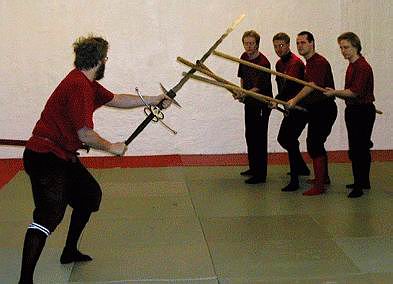
My sword site
|
|
   |
 |
Gabriel Stevens

|
 Posted: Fri 12 Dec, 2003 9:09 pm Post subject: Posted: Fri 12 Dec, 2003 9:09 pm Post subject: |
 |
|
Here's some from the St. Louis art museum.
 Attachment: 12.94 KB Attachment: 12.94 KB
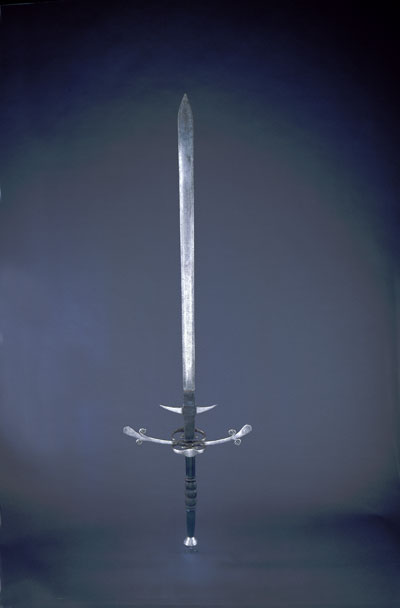
|
|
    |
 |
Gabriel Stevens

|
 Posted: Fri 12 Dec, 2003 9:10 pm Post subject: Posted: Fri 12 Dec, 2003 9:10 pm Post subject: |
 |
|
And the other, a little more applicable to this post....
 Attachment: 25.89 KB Attachment: 25.89 KB
[ Download ]
|
|
    |
 |
|
Borger Kruge
Location: Norway Joined: 13 Sep 2003
Posts: 20
|
 Posted: Sat 13 Dec, 2003 1:29 pm Post subject: Posted: Sat 13 Dec, 2003 1:29 pm Post subject: |
 |
|
Wow, thanks for all the input, guys, and especially to Mr McDonald explaining the actual purpose of the waves. And I suspected this to be some sort of a "fantasy" feature. Shame on me 
Borger
|
|
  |
 |
|
Lafayette C Curtis
|
 Posted: Fri 05 Jan, 2007 9:11 am Post subject: Posted: Fri 05 Jan, 2007 9:11 am Post subject: |
 |
|
Hm. Don't the pikemen's postures in the ARMA photograph look a little bit odd? I've never really seen anybody do either the "charge" or "high charge" that way.
I doubt it would have made much difference, though. What could have made a difference is if the pikemen were moving, since they could have bowled over the two-handed swordsman by the sheer force of their rush.
|
|
  |
 |
Jean Henri Chandler

|
 Posted: Fri 05 Jan, 2007 10:21 am Post subject: Posted: Fri 05 Jan, 2007 10:21 am Post subject: |
 |
|
| Borger Kruge wrote: | Wow, thanks for all the input, guys, and especially to Mr McDonald explaining the actual purpose of the waves. And I suspected this to be some sort of a "fantasy" feature. Shame on me 
Borger |
I'm not sure the jury is out on the purpose of the 'waves'. Thats one theory, the fact is they really don't know. Another theory is that the wave like shape of the blade makes an effect kind of like serration, enhancing the effectiveness of a draw-cut. This jibes with the fact that these wave blades appear most often on the 'true' two-handers and on rapiers; both weapons which are tricky to use effectively in a clinch. Enhancing the draw-cut literally gives you another weapon when at very close range, and also makes it more risky for an opponent to grab your blade.
Jean
Books and games on Medieval Europe Codex Integrum
Codex Guide to the Medieval Baltic Now available in print
|
|
  |
 |
Jean Henri Chandler

|
 Posted: Fri 05 Jan, 2007 10:24 am Post subject: Posted: Fri 05 Jan, 2007 10:24 am Post subject: |
 |
|
| Björn Hellqvist wrote: | | Hi, Borger! As for the Lutels, they are less wavy than their historical counterparts, but the waves go all the way down to the point. The wavy zweihänders are quite manageable. The pic shows some Swedish ARMA guys testing zweihänder vs pikes. You can just see the waves in the blade. |
Thats very interesting Bjorn, thanks for posting that. I wanted to ask, was there any attempt made to cut the 'pikes' ? I would love to see some light shed on this debate over wheather zwiehanders could cut of pike -heads.
We did a kind of similar test here in New Orleans about two weeks ago, I had a colleague hold a 14' wooden pole (I'm not sure what kind of wood it was) and I cut it with my Albion constable. I had no problem cutting through it, in fact I 'carroted' it, cutting off 4 or 5 small pieces in rapid succession. Unfortunately we didn't have the camera at the time, I'm planning to try this experiment again and film it as soon as I can find another long pole like that.
J
Books and games on Medieval Europe Codex Integrum
Codex Guide to the Medieval Baltic Now available in print
|
|
  |
 |
Steve Grisetti

|
 Posted: Fri 05 Jan, 2007 3:35 pm Post subject: Posted: Fri 05 Jan, 2007 3:35 pm Post subject: |
 |
|
| Jean Henri Chandler wrote: | | Björn Hellqvist wrote: | | Hi, Borger! As for the Lutels, they are less wavy than their historical counterparts, but the waves go all the way down to the point. The wavy zweihänders are quite manageable. The pic shows some Swedish ARMA guys testing zweihänder vs pikes. You can just see the waves in the blade. |
Thats very interesting Bjorn, thanks for posting that. I wanted to ask, was there any attempt made to cut the 'pikes' ? I would love to see some light shed on this debate over wheather zwiehanders could cut of pike -heads. |
I'm not Björn Hellqvist (he hasn't posted here since May of 2005, btw), but wanted to comment. I wasn't aware of a debate over whether zweihanders could cut pike heads off. I just received a book on the Landsknechts over the holidays, which says that the main purpose for the front line of doppelsöldner, equipped with the zweihanders, was to do exactly that.. (The book is one of the Osprey series, Men-at-Arms No. 58, so, I know everything in it shouldn't be taken for absolute fact.)
| Quote: | | We did a kind of similar test here in New Orleans about two weeks ago, I had a colleague hold a 14' wooden pole (I'm not sure what kind of wood it was) and I cut it with my Albion constable. I had no problem cutting through it, in fact I 'carroted' it, cutting off 4 or 5 small pieces in rapid succession. |
Sounds impressive - how thick was the pole? I guess the kind of wood used would be an important variable, but one of those Landsknecht zweihanders might be able to wack a pike with a lot more impact than the Constable, just due to sheer size.
"...dismount thy tuck, be yare in thy preparation, for thy assailant is quick, skilful, and deadly."
- Sir Toby Belch
|
|
  |
 |
Michal Grosenbach

Location: Elgin, IL USA Joined: 28 Aug 2006
Posts: 7
|
 Posted: Fri 05 Jan, 2007 7:00 pm Post subject: Posted: Fri 05 Jan, 2007 7:00 pm Post subject: |
 |
|
Hey Borger,
Concerning your Q on weakening the blade, I'd say "yep", especially the Zweihander, due to the tight radii. It would just create stress points or additional weight to reinforce them, I'm thinkin'... which is possibly why modern repro's have more gradual waves...?
|
|
  |
 |
Jean Thibodeau

|
 Posted: Fri 05 Jan, 2007 7:21 pm Post subject: Posted: Fri 05 Jan, 2007 7:21 pm Post subject: |
 |
|
| Michal Grosenbach wrote: | Hey Borger,
Concerning your Q on weakening the blade, I'd say "yep", especially the Zweihander, due to the tight radii. It would just create stress points or additional weight to reinforce them, I'm thinkin'... which is possibly why modern repro's have more gradual waves...? |
I would agree that if the arcs meet and change direction suddenly at one very small point: If they meet and form a small radius there would be less of a stress riser and if the blade undulate with convex and concave arcs of about the same length and staggered so that a convex on one side of the blade corresponds to a concave on the other side there should be no points of concentrated stress.
You can easily give up your freedom. You have to fight hard to get it back!
|
|
  |
 |
Steven H

|
 Posted: Fri 05 Jan, 2007 11:02 pm Post subject: cuting off pike heads Posted: Fri 05 Jan, 2007 11:02 pm Post subject: cuting off pike heads |
 |
|
I would suggest that pike heads could be cut-off by large swords.
And that they couldn't.
A general overview of spear and pike development starts without langets and moves to some langets, to subtantial langets. For the period of European pike use (as opposed to Greek). I believe that most pikes had multiple steel or iron langets. It seems logical that langets were added because without them the poles could be damaged or broken.
So I reason that originally, polearm heads could be cut by large swords, other polearms etc.
But then the question is whether or not the zweihander could cut a plate of iron backed by and inch of ash and reinforced with three other plates of iron. That seems far less likely to me (effectively impossible because it would so unlikely to succeed that trying would be counter-productive).
I'm not aware of any historical evidence to suggest that zweihanders were used to cut pike-heads off, even if they could. Though I know of multiple admonitions by fight masters to attack your opponent and not his weapon.
A hypothesis I've been working on.
Kunstbruder - Boston area Historical Combat Study
|
|
   |
 |
Kirk Lee Spencer

|
 Posted: Sat 06 Jan, 2007 10:53 am Post subject: Posted: Sat 06 Jan, 2007 10:53 am Post subject: |
 |
|
It is good to see this thread resurrected... But before I noticed, for just a moment, I thought Bjorn was back 
It is interesting to me to see several threads on the Flamberge blade because, Lord willing, my next sword will have such a blade.
ks
 Attachment: 93.82 KB Attachment: 93.82 KB

Two swords
Lit in Eden’s flame
One of iron and one of ink
To place within a bloody hand
One of God or one of man
Our souls to one of
Two eternities
|
|
  |
 |
Glen A Cleeton

|
 Posted: Sat 06 Jan, 2007 3:50 pm Post subject: Posted: Sat 06 Jan, 2007 3:50 pm Post subject: |
 |
|
The way I see it, scallops or waves would be benifical to controlling another blade, or sliding down a pike haft to get at the users hands and the user themselves. After all, the end game is the other guy, not their weapon. Beat aside the pike and take out the soldier.
Whether they could cut the pole or no, it seems unlikely the pikeman would just stand there and not try to poke or whack you again.
As to the straight blades with the scalloped type geometery, there had been thought put forth (on one board or another) that it was, at the very least, a way to lighten a long blade. In other words, provide a rigid blade with less mass. It would be interesting to measure thickness and distal on a mess of biggies.
Cheers
GC
Cheers
|
|
  |
 |
Jean Henri Chandler

|
 Posted: Sat 06 Jan, 2007 7:33 pm Post subject: Posted: Sat 06 Jan, 2007 7:33 pm Post subject: |
 |
|
| Quote: | | Sounds impressive - how thick was the pole? I guess the kind of wood used would be an important variable, but one of those Landsknecht zweihanders might be able to wack a pike with a lot more impact than the Constable, just due to sheer size. |
The pole was pretty thick, at least 2". The wood wasn't anything special though, like whatever they used to make your larger mop handles in the old days. I'm not sure what kind of wood was used in pike-hafts? I imagine something like ash maybe?
If I can figure out where to get another great big pole like that I'll be glad to repeat the experiment and film it. We just did it that day at the end of a lot of test-cutting kind of on the spur of the moment (we had run out of things to cut and saw the pole, and came up with that idea...)
That Albion Constable, incidentally, though light sharply tapering and obviously designed for the thrust (being an Oakeshott XVa) is an amazingly good little cutter. I can cut tatami mats and thick cardboard tubes easily, let alone stuff like soda bottles and the like. I even cut a (supermarket) chicken in half with one stroke one time.
Jean
Books and games on Medieval Europe Codex Integrum
Codex Guide to the Medieval Baltic Now available in print
|
|
  |
 |
Jean Henri Chandler

|
 Posted: Sat 06 Jan, 2007 7:35 pm Post subject: Posted: Sat 06 Jan, 2007 7:35 pm Post subject: |
 |
|
| Glen A Cleeton wrote: | The way I see it, scallops or waves would be benifical to controlling another blade, or sliding down a pike haft to get at the users hands and the user themselves. After all, the end game is the other guy, not their weapon. Beat aside the pike and take out the soldier.
Whether they could cut the pole or no, it seems unlikely the pikeman would just stand there and not try to poke or whack you again.
As to the straight blades with the scalloped type geometery, there had been thought put forth (on one board or another) that it was, at the very least, a way to lighten a long blade. In other words, provide a rigid blade with less mass. It would be interesting to measure thickness and distal on a mess of biggies.
Cheers
GC
Cheers |
Somebody should do a cutting test with a wave-bladed sword, and an equivalent as possible strait sword, and compare cutting, draw-cutting, cutting of wooden poles, etc.
Personally I'm convinced it's for draw-cutting, like a serrated kitchen knife.
J
Books and games on Medieval Europe Codex Integrum
Codex Guide to the Medieval Baltic Now available in print
|
|
  |
 |
Jean Thibodeau

|
 Posted: Sat 06 Jan, 2007 8:08 pm Post subject: Posted: Sat 06 Jan, 2007 8:08 pm Post subject: |
 |
|
| Jean Henri Chandler wrote: | Personally I'm convinced it's for draw-cutting, like a serrated kitchen knife.
J |
I tend to agree with that as I have many Spyderco blades and the serrations are very aggressive in cutting action.
My Spydercos are all hair popping sharp so that would prove little but some of my butter knife dull steak knives still cut very well with their serrated blades.
Do wavy blade cut much better ? It guess if a strait blade can cut one in half easily a blade capable of doing it twice as easily won't make a lot of difference in a practical sense i.e. if 100% effective multiplying this by 2X to 200% is of debatable use.
On the other hand even a dull serrated blade should be a lot more effective with a draw cut with minimum effort.
I would be surprised that waves make no difference but they sure look " mean " and the psychological warfare effect of
" scary weapons " shouldn't be underestimated.  Oh, and they have good aesthetics. Oh, and they have good aesthetics. 
You can easily give up your freedom. You have to fight hard to get it back!
|
|
  |
 |
Jean Henri Chandler

|
 Posted: Sat 06 Jan, 2007 8:31 pm Post subject: Posted: Sat 06 Jan, 2007 8:31 pm Post subject: |
 |
|
| Jean Thibodeau wrote: |
On the other hand even a dull serrated blade should be a lot more effective with a draw cut with minimum effort. |
Exactly and if you look at the type of swords which typically had these 'wave' blades, at least in Europe, it's most commonly rapiers and zweihanders, both weapons which are succeptible to being grabbed by the opponent in a fight, and are clumsy in a clinch. Grabbing the opponents blade is a tactic in nearly every period fencing manual I have seen on rapiers.
I would be surprised that waves make no difference but they sure look " mean " and the psychological warfare effect of
" scary weapons " shouldn't be underestimated.  Oh, and they have good aesthetics. Oh, and they have good aesthetics.  [/quote] [/quote]
Yes I would be surprised to, especially since they seem to have made so many of them, there are tons of surviving zweihanders with wavey blades in particular in muesums, castles, and auction houses all over the world. I can't remember how many I've seen. They almost seem more common than the non wavey ones.
One thing I have learned since I really started studying what you might call spathology; none of the parts of a sword was made in vain. Every component seems to have a specific purpose.
Thats why fantasy swords don't look right to me any more. All those wings and spikes, there is either no purpose to them or they are actually counterproductive. The functional elegance of the real thing is so much more appealing to me now.
J
Books and games on Medieval Europe Codex Integrum
Codex Guide to the Medieval Baltic Now available in print
|
|
  |
 |
|
|
You cannot post new topics in this forum
You cannot reply to topics in this forum
You cannot edit your posts in this forum
You cannot delete your posts in this forum
You cannot vote in polls in this forum
You cannot attach files in this forum
You can download files in this forum
|
All contents © Copyright 2003-2025 myArmoury.com — All rights reserved
Discussion forums powered by phpBB © The phpBB Group
Switch to the Basic Low-bandwidth Version of the forum
|

